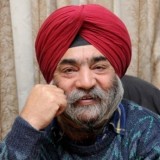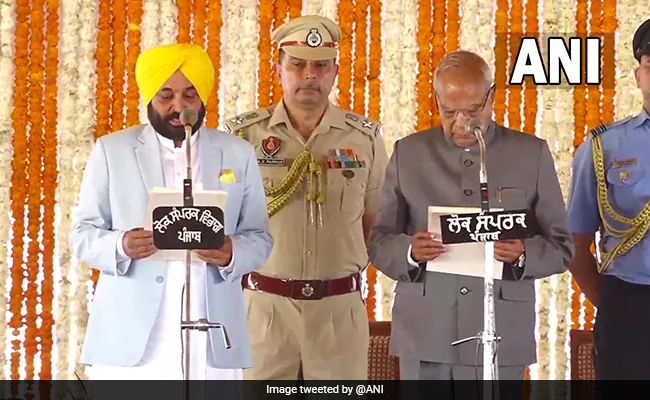
It has been a mixed start- more cautious and less controversial- for new Chief Minister Bhagwant Singh Mann and his AAP government. The new government has gone through the initial Constitutional and ritualistic formalities by following the parliamentary and conventional practices. Swearing in of the Chief Minister Bhagwant Mann at Khatkar Kalan, the native village of Shaheed-e-Azam Bhagat Singh, was perhaps the first and the only deviation from the existing practice of holding the solemn ceremony mostly at Raj Bhavan or rarely at a public place, like a stadium. Rest of the Constitutional mandates, including swearing in of members of the Council of Ministers, oath taking by members of new Vidhan Sabha, election of Speaker, and subsequently the opening session of the Legislature where Vote on Account and Interim Budget for first three months of the new financial year were all gone through by the laid down procedures.
Another deviation, if at all, was to defer debate on the Governor’s address till the next session of the Assembly. The reason given was shortage of time as well as to give time to nearly 80 per cent members making their debut in legislative politics to go through the address and come prepared for debate on it after a break.
The next session will, in all probability, be held in June to pass the full budget for 2022-2023. The new Finance Minister Harpal Singh Cheema needs to sit with the senior functionaries of his department and other heads to decide allocations in consonance with the promises the ruling party has made to the electors of Punjab.
In between, members will meet by the end of the month to complete the formality of electing five new members of Rajya Sabha. The process of nomination has already been completed. It is the filling of Rajya Sabha seats that has evoked criticism of the Opposition parties. The criticism, unanimous and vociferous, veered around naming of “outsiders” as representatives of the State in the Upper House of Parliament. Called the House of “Elders”, Rajya Sabha members from Punjab have traditionally been senior members of major political parties, especially of Congress, Shiromani Akali Dal, and Bharatiya Janata Party.
This time, AAP, with a landslide mandate, has chosen faces that are mostly new to Parliamentary politics. Two businessmen, two political strategists and a cricketer will now represent the State in the House of “Elders”.
These nominations bring to focus the role representatives of Punjab had been playing in both the Houses of Parliament – Lok Sabha and Rajya Sabha. Punjab has the distinction of sending several top political leaders, including Inder Kumar Gujral (who rose to be the Prime Minister of the country), besides several Union Ministers holding important portfolios like Defense, Home and Agriculture. These personal accolades apart, the State has generally remained without Statesmen leaders like Kapur Singh who remained steady and firm on demands and issues of the State. While Inder Kumar Gujral is credited with waiving a part of the debt the State incurred in its fight against terrorism, other major demands, including autonomy t States, for which Punjab witnessed long spells of agitations, both peaceful and armed, were generally swept under the carpet.
Over the years, or to be precise after Independence, the State has lost control not only of its new capital Chandigarh (that it built after losing Lahore to Pakistan), but also control on its river waters, power projects like Bhakra and Beas dams and institutes like Panjab University, Punjab Engineering College and the Postgraduate Institute of Medical Education and Research.
Going by the record of both Lok Sabha and Rajya Sabha, the pitch for these long-standing demands appears to have been lost. Compromises, generally for power, were made and to fight Centre for backing out of its commitments, including transfer of Chandigarh to Punjab in mid 80s, none of its representatives, both in Lok Sabha and Rajya Sabha, ever made a sincerely noticeable effort. Even the sacrifice of Darshan Singh Pheruman in support of these demands was ignored.
No doubt Punjab is an agricultural State, but it does not mean that it does not need industry for its overall economic development. When militancy was at its peak, several incentives, including industrialization, were promised. But none of these promises, including development of Sri Goindwal Sahib, as an industrial hub in the border belt were kept. Instead, the State witnessed a flight of industry to neighboring hilly States of Himachal Pradesh and Uttarakhand in general. Even at that time, the pitch of the protest raised by Punjab MPs was so frivolous as to be audible elsewhere.
No one will support outsiders to represent the State in Parliament. The million-rupee question is “Are our political parties and their bigwigs acting at the behest of the State or are just appeasing a section of their loyalists at the cost of the State?”
Answers may generate an animated debate about the practices followed in the past viz a viz recent action of the first-time ruling group. Whatever be the outcome, the State needs a government that works for finding solutions to its vexed and long-standing demands besides attending to its conjugal problems.
(Prabhjot Singh is a veteran journalist with over three decades of experience covering a wide spectrum of subjects and stories. He has covered Punjab and Sikh affairs for more than three decades besides covering seven Olympics and several major sporting events and hosting TV shows. For more in-depth analysis please visit probingeye.com or follow him on Twitter.com/probingeye. He can be reached at prabhjot416@gmail.com)
